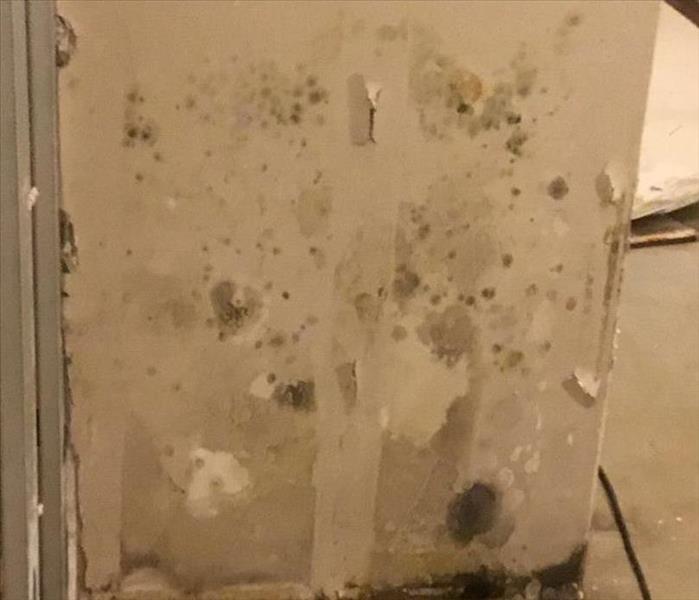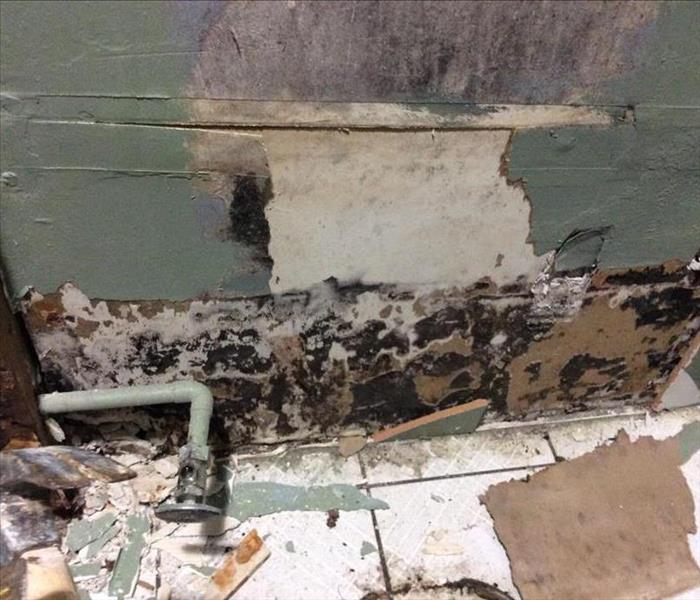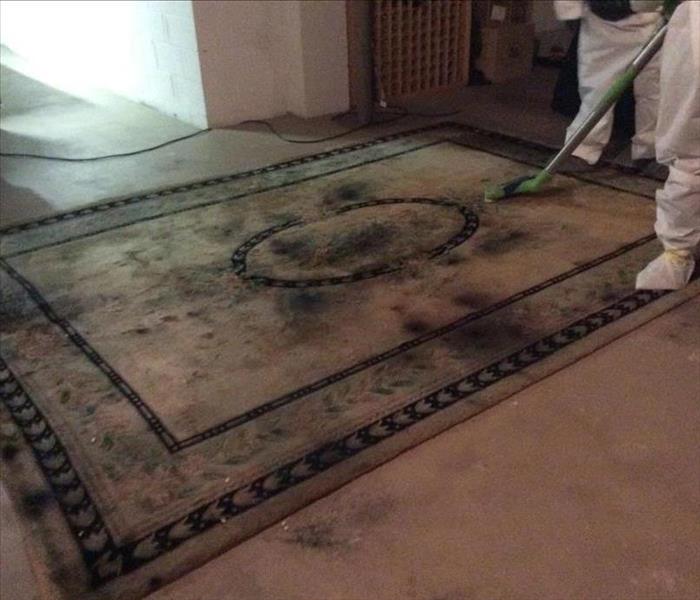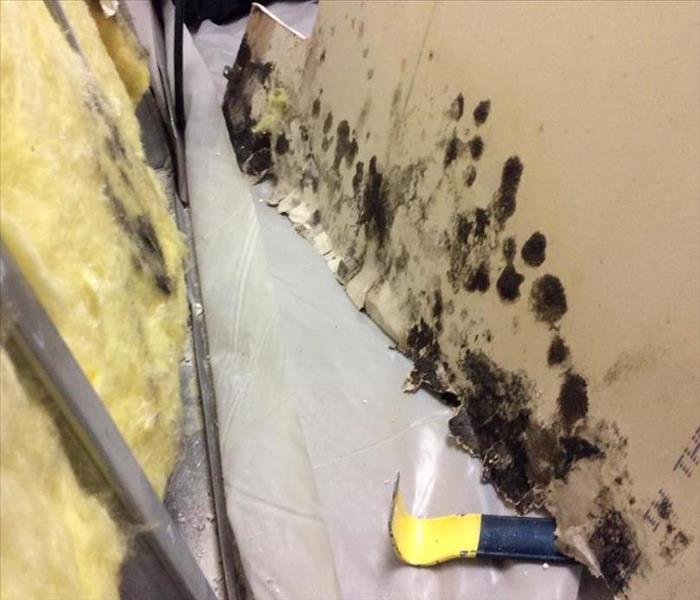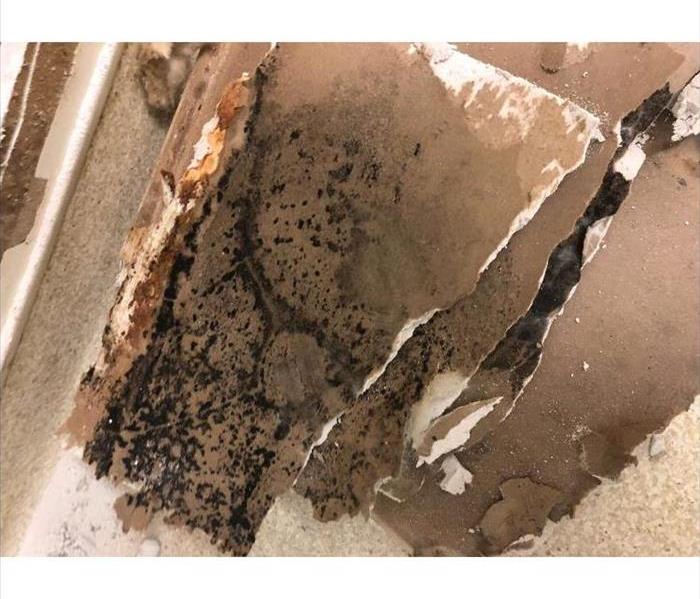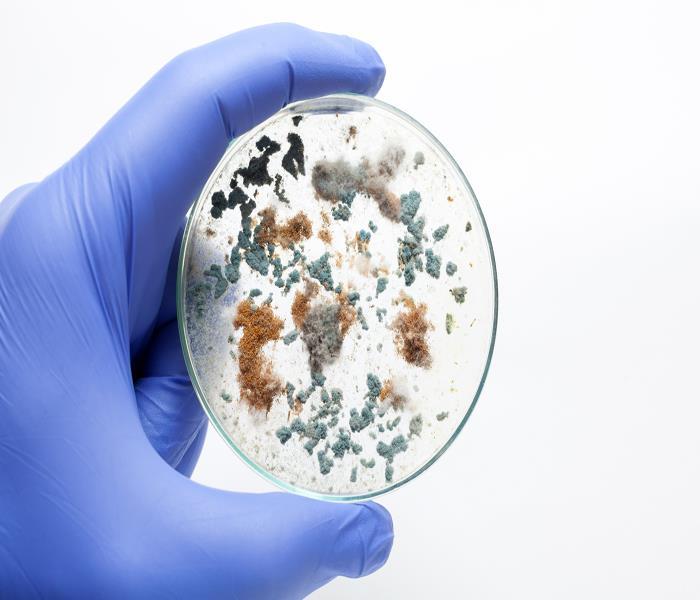Recent Mold Remediation Posts
The Challenge with Mold Sampling
5/27/2022 (Permalink)
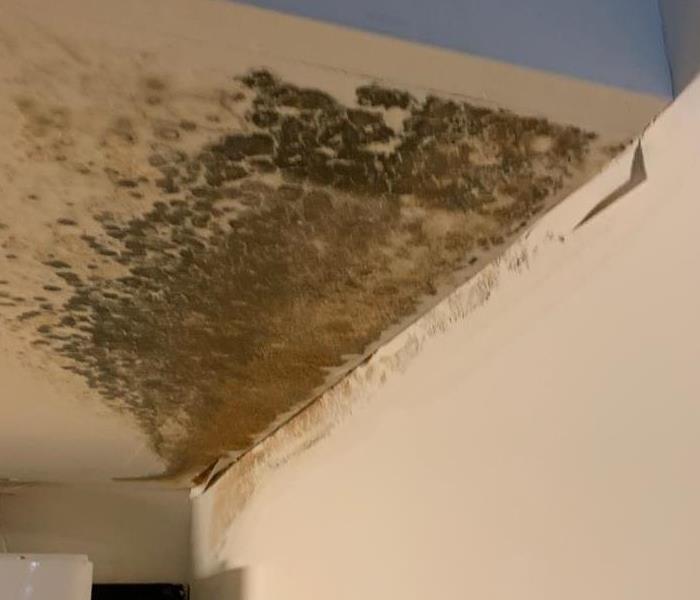 Noticeable mold growth in the home.
Noticeable mold growth in the home.
The Challenge with Mold Testing or Sampling
Is sampling for mold needed?
In most cases, if visible mold growth is present, sampling is unnecessary. Since no EPA or other federal limits have been set for mold or mold spores, sampling cannot be used to check a building's compliance with federal mold standards. Surface sampling may be useful to determine if an area has been adequately cleaned or remediated. Sampling for mold should be conducted by professionals who have specific experience in designing mold-sampling protocols, sampling methods, and interpreting results. Sample analysis should follow analytical methods recommended by the American Industrial Hygiene Association (AIHA), the American Conference of Governmental Industrial Hygienists (ACGIH), or other professional organizations.
Are there federal regulations or standards regarding mold testing?
Standards or Threshold Limit Values (TLVs) for airborne concentrations of mold, or mold spores, have not been set. Currently, there are no EPA regulations or standards for airborne mold contaminants.
Please note that SERVPRO does not conduct mold testing. We are specialists in the remediation of mold and believe that separating mold detection and its remediation eliminates any potential conflict of interest. Call us today for a free consultation.
Mold is Everywhere
5/27/2021 (Permalink)
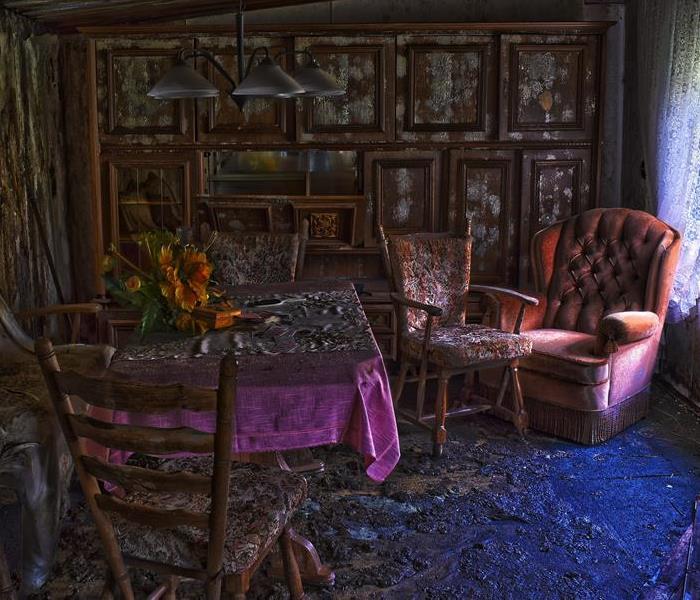 Living Room covered in mold.
Living Room covered in mold.
Did you know that mold is everywhere, both outside and inside your home? The spores are constantly floating around and cause little adverse issues until they find a nice moist place to grow. This is where small leaks in roofs, pipes, basements, windows, etc. can create a serious problem for both health and property.
Places where mold often appears include:
- areas where leaks occur, especially behind walls and concealed by sheetrock
- where flooding has occurred
- areas that routinely get wet (where is your dog's bowl?)
- windows where condensation builds up
- places where the air does not circulate well
- wet cellulose materials are most supportive of mold growth.
Molds produce spores, which spread by floating in the air. Mold spores are present in all indoor environments. There is no way to prevent spores, and they can persist in conditions where mold itself cannot grow.
Mold spores thrive in environments that are moist and warm, so when they land on a damp spot, they begin to grow.
Molds can grow on a variety of different surfaces, including fabric, paper, wood, glass, and plastic. As they grow, they may digest the material they are growing on.
Molds are classified in three different ways:
Allergenic: Molds that cause and produce health effects.
Pathogenic: Molds that cause health effects in those suffering from an acute illness.
Toxigenic: Molds that produce toxic substances that can lead to health effects. This is sometimes referred to as “toxic mold.”
PROFESSIONAL MOLD REMOVAL
Getting rid of mold is a very complex undertaking. Not only is mold difficult to identify, but it’s also dangerous to be around. SERVPRO uses mold remediation equipment and techniques that protect both you and our team. Our remediation strategy is specifically designed to address the damage that has already occurred and prevent the problem from recurring.
Not sure if there is an issue?:
SERVPRO intentionally does not do mold testing to prevent any potential conflict of interest. Often times the mold is obvious to our technicians. If there is uncertainty, we can recommend a reputable testing company that can help. Based on their findings we will develop a plan to address the remediation.
Call us today for more information.
Does your house have a mold problem?
5/20/2020 (Permalink)
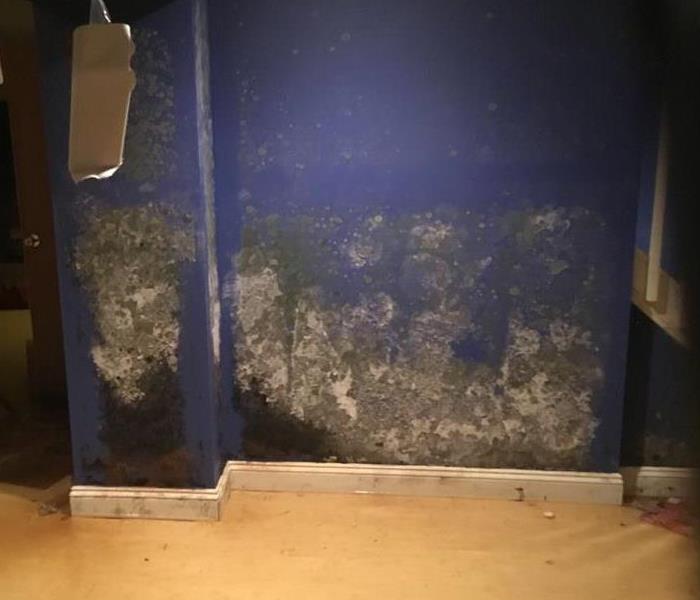 Mold Damage in Basement of a Residential Home
Mold Damage in Basement of a Residential Home
Microscopic mold spores naturally occur almost everywhere, both outdoors and indoors. This makes it impossible to remove all mold from a home or business. Therefore, mold remediation reduces the mold spore count back to its natural or baseline level. Some restoration businesses advertise “mold removal” and even guarantee to remove all mold, which is a fallacy. Consider the following mold facts:
- Mold is present almost everywhere, indoors and outdoors.
- Mold spores are microscopic and float along in the air and may enter your home through windows, doors, or AC/heating systems or even hitch a ride indoors on your clothing or a pet.
- Mold spores thrive on moisture. Mold spores can quickly grow into colonies when exposed to water. These colonies may produce allergens and irritants.
- Before mold remediation can begin, any sources of water or moisture must be addressed. Otherwise, the mold may return.
- Mold often produces a strong, musty odor and can lead you to possible mold problem areas.
- Even higher-than-normal indoor humidity can support mold growth. Keep indoor humidity below 45 percent.
If your home or business has a mold problem, we can inspect and assess your property and use our specialized training, equipment, and expertise to remediate your mold infestation.
If You See Signs of Mold, Call Us Today – SERVPRO of Eatontown/Long Branch at 732-578-9888
Mold Myths
1/29/2020 (Permalink)
Mold is one of those words that triggers an alarm - its dangerous and will create health problems are two of the most troubling concerns.
When suspected mold is discovered, it is best left to the professionals to remediate, simply because there are too many variables and mold is tricky. It is also because there are many "untruths" about mold:
Myth 1.) “All Mold is Dangerous and Unhealthy”
In fact, some kinds of mold make human life better. Just think of the life saving benefits of penicillin or the delicious taste of bleu cheese on a salad. These all come from mold.
While it’s true that some molds do cause health problems, the effects of mold on people can vary dramatically from person to person. Some molds produce allergens that can make life miserable for people sensitive to this allergy, and people with compromised immune systems are also often at greater risk to become sick from repeated mold exposure.
Myth 2.) “Bleach Kills All Mold Growth”
Many people when they discover mold in their homes immediately reach for the bleach and assume this will solve the problem. Unfortunately, this is not always the case.
Bleach may kill certain kinds of mold growth, especially on non-porous surfaces. But bleach has not been proven to be effective on all kinds of mold, and it frequently doesn’t work so well on porous materials such as wood.
In addition, the amount of bleach that may be needed to clean-up a mold problem may in turn pose its own health risks.
Myth 3.) “If There’s Just a Little Mold, You Don’t Have to Worry”
Many people believe that if they see jut a little mold, they don’t have to worry about it. Unfortunately, sometimes a little mold is a big problem.
While it is true that mild mold growth may not cause any problems, what you see may not in fact be merely mild growth. Mold can be like an iceberg where what is visible is only the tip of major growth lurking beneath the surface.
Often times, the first visible signs of mold are just a signal that you have a major mold issue that needs to be remedied.
Myth 4.) “You Can Clean-Up Mold Yourself with Home Remedies”
According to the EPA, if your mold problem is “less than about 10 square feet (less than roughly a 3 ft. by 3 ft. patch), in most cases, you can handle the job yourself.” However, as was just discussed, many times the mold you see is just the surface of a larger underlying problem.
If you even suspect that your mold problem may be larger than 10 square feet, or you’ve been experiencing health symptoms that may be related to mold exposure, you should bring in a professional mold remediation service provider as soon as you can.
SERVPRO of Eatontown/Long Branch has the training and equipment necessary to thoroughly inspect and address any mold issues you may encounter. We’ve helped many homes and businesses in the community with mold problems both large and small, including providing 24/7 emergency services.
When You Should Call for Professional Services to Clean Up Mold
5/10/2019 (Permalink)
Spring showers may bring new flowers…but Spring flooding can also lead to mold growth in your home or business. Mold is a common side effect of water damage, and once it starts growing, it may require professional clean-up services to fully remove it.
We at SERVPRO of Eatontown/Long Branch, are proud to be a leader in professional cleaning and restoration services for this community. We’re experts in dealing with the aftereffects of major flooding and water damage, helping homes and businesses throughout this area restore their properties to like-new conditions. We want to help make sure you stay safe from the hazards of mold.
Much misinformation has been spread about mold. The truth is, there are many types of mold that come in many colors, and not all types are as potentially dangerous as others.
Common symptoms associated with hazardous mold exposure can include skin irritation, congestion, itchy eyes, or sinus problems. People who already have allergies, immune deficiencies, and upper respiratory issues may be at greater risk when exposed to hazardous mold.
The first thing to remember about cleaning up is that mold is the result of a water problem. So, the first step to getting rid of the mold is to identify and fix the source of the water issue. If you don’t, the mold is likely to return, even after a thorough cleaning.
When you ought to call for professional clean-up help
- If you have significant water damage.
- If you have damp areas you’re not able to thoroughly dry yourself.
- If you have mold growth beyond 10 square feet.
If your home or business needs clean up help with black mold, know that SERVPRO of Eatontown/Long Branch is here 24/7 to help. Our friendly expert technicians have the advanced training and professional grade equipment needed to stop your mold problem for good and restore your property.
Keep Your Home Safe From Mold
3/26/2019 (Permalink)
Most homes have basements, attics, crawl spaces or garages that provide habitats for mold. All that is needed is a dark, damp, warm environment. If you have water damage, water leaks, a leaky roof, a washing machine that overflows frequently or any other chronic water/moisture issue, mold can take a toehold and thrive.
sometimes water damage can lurk behind walls where it is not apparent. SERVPRO professionals can use a moisture meter and infrared cameras see if anything is leaking.
So what can you do to reduce your exposure to mold? Attack mold on two fronts -- removal and prevention:
Fix leaky plumbing or other sources of water. If you have mold in your crawl space or basement, locate the source and stop the water from coming in.
Dry water-damaged areas and items (like carpeting) within 24 to 48 hours of flooding. Throw out all wet, moldy tiles and carpeting.
Reduce indoor humidity by venting bathrooms, dryers, and other moisture-generating sources. Exhaust fans in bathrooms and kitchens can help. If you don’t have exhaust fans, crack a window in the kitchen when you're cooking or in the bathroom when you're bathing.
In the summer use air conditioners and dehumidifiers inside your home. Change filters regularly. Use a dehumidifier to get rid of dampness in basements.
In the winter, add insulation to windows, piping, exterior walls, roof, or floors where there is potential for condensation on cold surfaces.
If you suspect or see mold anywhere in your home, get your house tested for mold. A moisture meter test will help, and dust samples from your carpet can show whether mold spores are in your home. If you DO have mold, call SERVPRO of Eatontown/Long Branch, and our certified experts will put a remediation plan in place to get rid of it.
10 Things you need to know about mold
3/6/2019 (Permalink)
One of the biggest concerns for local residents is mold. Do I have mold? Is it bad? Are my kids safe?
Here are 10 basic things you need to know about mold:
- Mold can cause health effects.
- There is no practical way to eliminate ALL mold and mold spores in the indoor environment; the way to control indoor mold growth is to control moisture.
- If mold is a problem in your home or school, you must clean up the mold and eliminate sources of moisture.
- Fix the source of the water problem or leak to prevent mold growth.
- Reduce indoor humidity (to 30-60%) to decrease mold growth by:
- Venting bathrooms, dryers and other moisture-generating sources to the outside
- Using air conditioners and de-humidifiers
- Increasing ventilation
- Using exhaust fans whenever cooking, dishwashing and cleaning
- Clean and dry any damp or wet building materials and furnishings within 24-48 hours to prevent mold growth.
- Cleaning mold jis difficult - calling a specialist is best.
- Prevent condensation: Reduce the potential for condensation on cold surfaces (i.e., windows, piping, exterior walls, roof, or floors) by adding insulation.
- In areas where there is a perpetual moisture problem, do not install carpeting (i.e. basements) unless well ventilated.
- Mold IS everywhere and depending on the right environment, can grow and thrive. Food sources include wood, paper, carpet, and foods. Not all mold is a potential health threat, but knowing the difference is key.
Knowing the facts is the best way to prevent a potential mold problem. The BEST step is hiring a licensed professional to test and then have SERVPRO of Eatontown/Long Branch do the remediation. Our 50 years of experience counts when it comes to removing mold from your home. Call us today.
The Science Behind Mold
2/6/2019 (Permalink)
Not all molds are actually toxic. That’s the good news. Unfortunately, there are plenty of other molds that are toxic -- but they’re not black.
If you’re concerned about mold in your home or business, here are the basics you need to know in order to keep safe:
What Kinds of Mold Are Toxic
If you follow the news, you’ve probably heard the scientific term Stachybotrys used to categorize black mold that produces toxins. (Specifically, the toxins that are produced are mycotoxins, which is the scientific term for any toxic substance produced by a fungus).
However, mycotoxins are not always produced when mold is present. Scientists have identified specific strains of Stachybotrys, such as Stachybotrys chartarum and Stachybotrys atra, which have been shown to cause many health issues for humans. But as there are literally hundreds of thousands of mold species that we currently know of in existence, it’s not necessarily likely that you will have these particular kinds.
What’s more, dangerous mycotoxins can be produced by other kinds of mold besides Stachybotrys. And these molds don’t have to be black.
The bottom line is that your best protection against a mold problem is to prevent mold in the first place. And if you do see some mold, you need to know when it’s okay to try to clean it on your own (hint: only if it’s small in area, less than 10 square feet). In most situations, however, if you think you have a mold problem, you should call in professional services to be sure. Remember: safety first.
What You Can do to Reduce Your Exposure to Mold
1/23/2019 (Permalink)
So what can you do to reduce your exposure to mold? Attack mold first by prevention:
Get your house tested for mold. SERVPRO of Eatontown/Long Branch has a list of local environmental testing companies.
Fix leaky plumbing or other sources of water. If you have mold in your crawl space or basement, locate the source and stop the water from coming in.
Dry water-damaged areas and items (like carpeting) within 24 to 48 hours of flooding. Don't install carpeting in areas where there is a moisture problem.
Reduce indoor humidity by venting bathrooms, dryers, and other moisture-generating sources. If you don’t have exhaust fans, crack a window.
Use air conditioners and dehumidifiers inside your home. Change filters regularly. Use a dehumidifier to get rid of dampness in basements.
Add insulation to windows, piping, exterior walls, roof, or floors where there is potential for condensation on cold surfaces.
If you follow these tips, mold growth should be kept at bay. But if you DO find mold, call SERVPRO of Eatontown/Long Branch, and we will be out right away.
Things Remember to Keep Mold at Bay
1/2/2019 (Permalink)
Mold is a problem that can affect every home, and may be present even before it becomes visible. Mold likes to grow in dark and damp environments, so sometimes you'll notice a damp, moldy smell in the air long before you ever see signs of a mold problem. Here are three tips to stop it before it even gets started.
Temperature
Warmer weather can instigate mold growth. Areas in your home that are allowed to surpass the 80-degree mark are the most susceptible. I
In the winter, check places where condensation collects, such as windows and doors. The heat from your home reacting to the cold outside will create moisture, especially if the area is not well insulated. If you have an older home, consider adding weather strips around drafty openings.
Air Circulation
Mold thrives in environments where there is little or no air movement.
Vent fans, ceiling fans and strategically placed floor fans are excellent additions to bathrooms, or other places in your home where air can become stagnate.
Moisture
The last problem you need to be concerned about is probably the most important. Mold needs moisture to grow. Without moisture in some form, mold will dry up and turn to dust.
Leaks & Drips
Always fix water leaks and drips immediately though.
Gutters & Eaves
Clogged rain gutter can drip back under the eaves and begin to slowly seep behind your exterior walls.
Cleanliness
Dirt can also attract moisture as well as be a food source for mold. Vacuum at least once a week. If you have pets that shed, it would be well advised to vacuum a little more frequently.
Mold is everywhere, and once it starts to spread in your home it can become an expensive problem to remediate. Make sure you keep on top of issues when they arise to keep mold from affecting you!
A Wet Spring May Mean Mold Growth in your Home
5/10/2018 (Permalink)
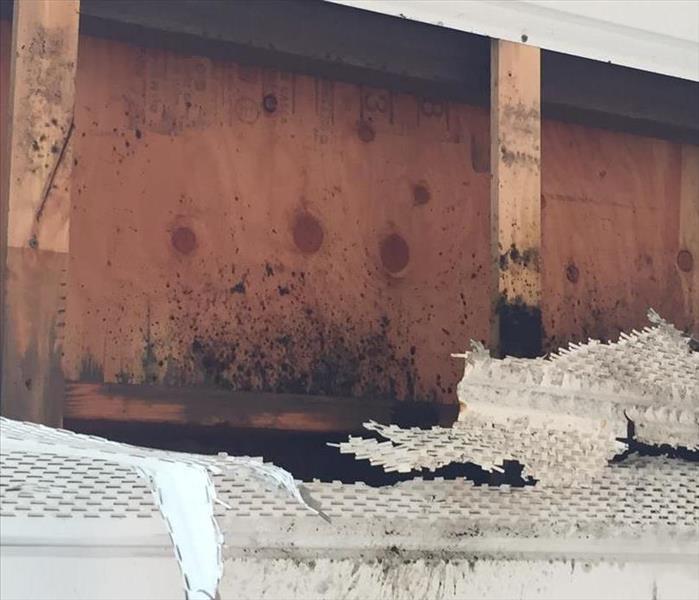 Mold can be found hidden anywhere.
Mold can be found hidden anywhere.
Springtime at the Jersey Shore is usually a month of wet, rainy weather followed by hot and humid temperatures. So it is important to be aware of the potential of mold growth in your home. Mold spores exist everywhere. Mold growth depends on certain conditions such as poor ventilation, moisture and air temperature. Every home has areas that have the potential for mold growth, so it is important to know where to look and what to look for. Places to look in your home that are susceptible to mold growth are areas that are constantly wet or humid such as:
- Bathrooms
- Kitchens
- Basements
- Windows/doors
- Crawl spaces
What you need to look for:- Discoloration on walls, carpets and floors
- Visible mold growth – black, white, red, orange, yellow, blue, violet, etc.
- Noticeable muster and/or dirt odor
Our technicians are IICRC certified and undergo weekly training. We screen all our employees with background checks so you can feel safe having us in your home. We follow EPA standards and our products are child/pet safe. If you find ANY mold in your home, it is always best to call a professional to take care of the issue. If you find you need our services, we are always open.
Where to Look For Moisture & Mold
3/26/2018 (Permalink)
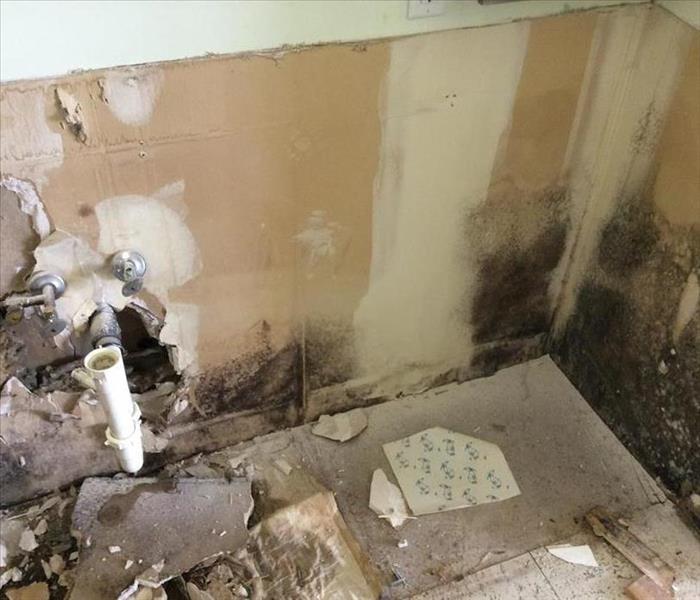 Hidden mold like this which was found when a bathroom sink was removed can spread and become a health problem.
Hidden mold like this which was found when a bathroom sink was removed can spread and become a health problem.
Mold growth depends on certain conditions for growth such as poor ventilation, moisture and air temperature. Every home has areas that have the potential for mold growth, so it is important to know where to look and what to look for.
The following is a list of places in your home that are susceptible to mold growth:
- Under sinks
- Behind washing equipment
- Under and behind refrigeration units
- Under dishwashers
- Behind toilets
- Behind and below water heaters
- Around tubs and showers
- Around doors and windows
- Around basement perimeters
- In crawl spaces
- Above ceiling tiles
- Around the outside hose bib
- Inside access panels to whirlpool tubs
What you need to look for:
- Discoloration on walls, carpets and floors
- Visible mild growth – black, white, red, orange, yellow, blue, violet, etc.
- Noticeable muster and/or dirt odor
If you do find any mold in your home, it is always best to call a professional to take care and remediate the issue. Mold spores are easily dispersed if incorrectly disturbed and most household cleaners won’t sufficiently take care of the problem.
SERVPRO of Eatontown/Long Branch is available 24/7/365 to help home and business owners take care of water, mold and fire disasters quickly and thoroughly.
Controlling Moisture Deters Mold Growth
3/6/2018 (Permalink)
 Mold growth in attics can be due to lack of moisture control and poor ventilation.
Mold growth in attics can be due to lack of moisture control and poor ventilation.
Water leaks, showers, cooking, all these things can add moisture to the air in your home. The amount of moisture the air in your home can hold depends upon the temperature. The warmer the air, the more moisture stays in the air. The lower the temperature, the less moisture is in the air.
At any temperature level, moisture can encourage biological pollutants to grow, which becomes the perfect habitat for mold growth.
So how do you begin to control moisture in your home? According to the EPA, the following steps can be taken to keep moisture – and subsequently mold – at bay:
Fix leaks and seepage. If water is entering the house from the outside, your options range from simple landscaping to extensive excavation and waterproofing.
Place a plastic cover over dirt in crawlspaces to prevent moisture from coming in from the ground. Be sure crawlspaces are well ventilated.
Use exhaust fans in bathrooms and kitchens. Make sure fans are vented to the outside, and not the attic.
Turn off certain appliances (such as humidifiers or kerosene heaters) if you notice moisture on windows and other surfaces.
Use dehumidifiers and air conditioners, especially in hot, humid climates.
Raise the temperature of cold surfaces where moisture condenses. Insulate storm windows and open doors between rooms to circulate warm air. Using fans and moving furniture away from wall corners can help increase air circulation.
Be careful of carpet on concrete floors. Carpet can absorb moisture and serve as a place for biological pollutants to grow. Use area rugs which can be taken up and washed often. In some climates it may be necessary to use a vapor barrier over the concrete.
While these tips may help control moisture in your home, it may not guarantee the complete prevention of mold growth. If you do suspect mold, have your home tested, and make sure a professional takes care of remediation safely and properly.
Why Bleach Isn’t an Effective Mold Remover
2/5/2018 (Permalink)
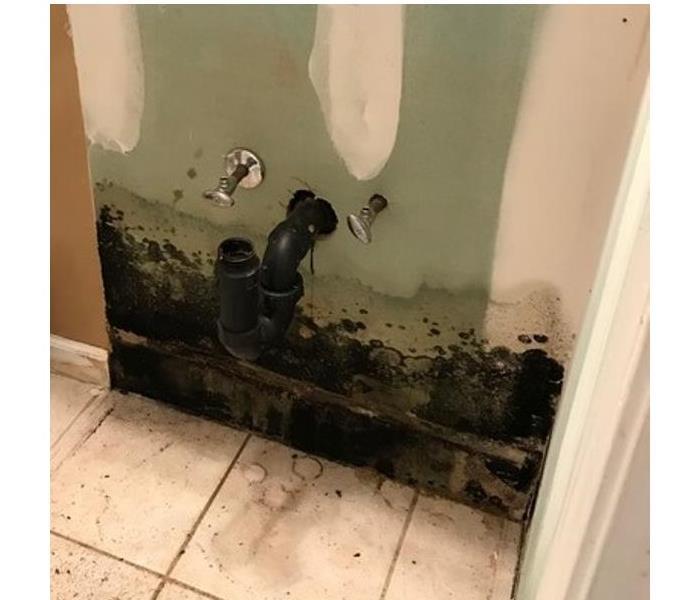 Mold can grow anywhere, but is most prevalent where there is leaking water, moisture and poor ventilation.
Mold can grow anywhere, but is most prevalent where there is leaking water, moisture and poor ventilation.
Most households have a bottle of chlorine bleach on hand that is designated for a host of uses such as cleaning, laundry or a disinfectant. This bleach is a combination of hypochlorite, chlorine and water.
As a disinfectant, chlorine bleach will kill many household molds, but not all of them. This is the reason that bleach is not recommended in removing mold from walls According to the Harvard School of Public Health, bleach will only kill 50% of mold growth on surfaces such as wallboard (sheet rock, plaster, etc.).
It can also be considered a dangerous substance if not used correctly.
This is why it is so important to leave mold remediation to professionals, who have the proper tools and products to remove mold. Attempting to remove mold yourself may result in mold spores being released and finding a foothold elsewhere in the home. Also cleaning agents will not effectively remove all the mold. In most cases anything affected such as the sheet rock, insulation, carpeting or carpet padding must be cut out and/or removed.
SERVPRO of Eatontown/Long Branch has certified and trained technicians who know how to properly clean and remove mold from your home safely and effectively. If you suspect you have a mold problem give us a call at 732-578-9888.
Mold Prevention is Your Best Defense
2/2/2018 (Permalink)
 Hidden moister or water behind a wall can be detected by our infrared sensors.
Hidden moister or water behind a wall can be detected by our infrared sensors.
Mold thrives in dark, damp, warm environments. If you have (or have had) water damage, water leaks, a leaky roof, a washing machine that overflows frequently or a basement that takes on water, even occasionally, the resulting moisture can give mold a toehold for growth.
In some instances, it can be hard to see the water damage. SERVPRO professionals can use a moisture meter and infrared cameras and find moisture or water behind walls.
So what can you do to reduce your exposure to mold? Attack mold on two fronts – prevention and removal.
- Fix leaky plumbing or other sources of water. If you have mold in your crawl space or basement, locate the source and stop the water from coming in.
- Check inside drywall for mold inside the wall. You can usually smell mold even if you can't see it. Moldy drywall must be cut out and replaced. Moldy insulation also must be removed and replaced.
- Use fans and heaters to dry water-damaged areasand items (like carpeting) within 24 to 48 hours of flooding.
- Replace ceiling tiles or carpet that have become moldy (or smell like mold).
- Reduce indoor humidity by venting bathrooms, dryers, and other moisture-generating sources. Exhaust fans in bathrooms and kitchens can help. If you don’t have exhaust fans, crack a window in the kitchen when you're cooking or in the bathroom when you're bathing.
- Use air conditioners and dehumidifiers inside your home. Change filters regularly. Use a dehumidifier to get rid of dampness in basements.
- Add insulationto windows, piping, exterior walls, roof, or floors where there is potential for condensation on cold surfaces. Mold can grow even in winter months.
- Get your house tested for mold. A moisture meter test will help. Check with your state health department or find a local environmental testing company.
- If you find or smell mold anywhere in your home, DO NOT try removing mold yourself. Instead, call the professionals at SERVPRO of Eatontown/Long Branch to put a remediation plan in place.
Mold Growth in Winter
1/9/2018 (Permalink)
Most people think that you need humid, moist air in order for mold to take hold and grow. While this is true, many other factors need to be present for mold growth.
During cold winter months, when there seems to be little moisture in the air, mold will still grow in places where there is a sufficient source of food (dead organic matter) and the right temperature. This usually occurs in cold, uninsulated exterior windows and walls, including uninsulated closets along exterior walls, where building surfaces are generally cold relative to the indoor air temperature. Cold surfaces next to warm oftentimes results in condensation (moisture), which is necessary for mold growth. And while extreme cold, freezing, and heat can deactivate spores, it does not kill them.
In order to keep winter mold growth at bay, try to control humidity in crawl spaces, basements and uninsulated closets, insulate exterior doors and windows and remove any material that mold will grow on, such as paper, cardboard, wood and fabrics.
If you do suspect mold growth, make sure you call professionals such as SERVPRO of Eatontown/Long Branch to take care of the removal and mitigation.
Winter Mold Growth: What You Need To Know
2/16/2016 (Permalink)
The wet season in the winter months is one of the best times of year for molds to grow and expand. Often mold is contained near sources of water where it can easily grow and reproduce. As it grows, mold can breakdown and compromise the integrity and strength of the source in which it lives.
Mold spores are microscopic and are naturally found in the air we breathe indoors and outdoors. When large amounts of spores grow, one’s health may be compromised. Mold can be killed, but if it is not removed properly, it can remain in the area just cleaned and the dry spores can be released into the air. Mold remediation services can help eliminate the mold in your home and personal items affected by water damage.
Prevention, however, is what will help keep your lungs healthy and homes and buildings strong. We’ve put together a few tips on how you can help thwart mold from infesting your home that are efficient and realistic:
General Home and Building Maintenance:
- Keep all areas clean.
- Make sure there is good air circulation. Use an exhaust fan or open a window when showering, cooking, and washing the dishes.
- Prevent mold and water damage by turning off the water flow to broken appliances and pipes.
- Replace cracked or defective mortar in basements. If you find your basement is wet or has water leaking into it, inspect the outside drainage systems.
- Spread moisture-barrier materials in crawl spaces over the soil. Heavy roofing paper or plastic film made of polyethylene can be used for this. Make sure there is good ventilation in the crawl space and, if possible, do not enclose it. One may need to use a fan to blow out humid air from under the building.
- One can get rid of humidity or dampness within a building by heating it for a short time. After heating, open up the doors and windows, or use an exhaust fan, to let out the air that is moist.
- Hire a professional roofing contractor to cover a damaged roof with a tarp or tent. This will help protect the building from the elements.
- If there are freezing temperatures, take measures to insulate pipes inside and out to ensure they will not crack and/or burst.
- Make sure all the seals on the windows and doors are not compromised and in good-working condition.
- Clean and repair roof gutters regularly.
- Make sure the ground around your building slopes away from the foundation so water does not collect around or enter in to it.
- Act quickly if you see condensation on windows, pipes, or walls inside a building. Dry out the area and determine if the source of the condensation is from a leak or the result of high humidity.
After a Flood or Heavy Rains:
- Work fast. Call in SERVPRO, which will help in the cleaning and disinfecting of your home from toxins and spores mold can release.
- Lower the humidity and temperature in the building: molds do not like these conditions. Open up windows if the air outside is less humid than the air inside. Otherwise, turn on an air conditioner and a dehumidifier.
- Dispose of moldy items in a sealed bag. Objects that can be saved should be frozen (which deactivates mold) or dried out. Mold remediation services can assist with restoring many of your items, including documents, pictures, and books.
- Make sure there is good ventilation within the building affected. Use a fan, if necessary, to promote good air circulation.
- Remove as much standing water in a building as quickly and safely as possible after disconnecting all electronic equipment inside the building.
- The two key things to remember in mold prevention are: 1. Keep everything clean, and 2. Keep everything dry. Many simple steps can be taken to prevent mold damage as well as water damage during the winter months. However, keep the number SERVPRO handy should you require their services. These professionals can efficiently and quickly ensure your home is safe, dry, and mold-free.
Best Defense Against Mold
11/11/2015 (Permalink)
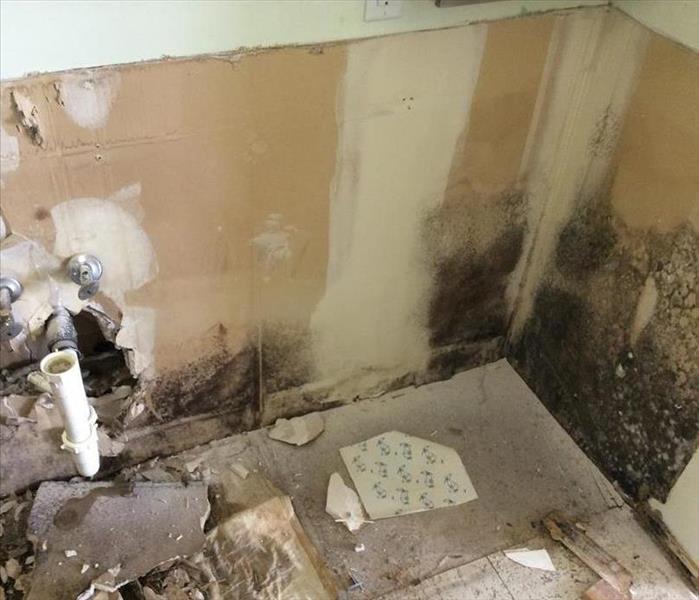 The SERVPRO of Eatontown/Long Branch Management Team meets with Bruce Wolf of Garden State Environmental Consultants to discuss mold remediation
The SERVPRO of Eatontown/Long Branch Management Team meets with Bruce Wolf of Garden State Environmental Consultants to discuss mold remediation
The first thing you should be aware of is that mold spores are absolutely everywhere. Fungal spores use air currents and water to spread, which is how they get inside homes and other buildings to begin with. The key to prevention is to ensure the atmosphere required for mold spores to mature and spread cannot be found in your home.
The following steps are the best defense against mold becoming a problem in your home.
- Clean and dry wet spots immediately
- Promptly remove any affected materials that cannot be thoroughly cleaned or dried
- Maintain indoor humidity levels below 60%
- Maintain plumbing and utilities to prevent leaks
- Run the bathroom exhaust fan a minimum of 20 minutes after a shower or bath
- Operate a dehumidifier in basement during hot and humid weather
- Ensure attic vents are open and clear of insulation for outside air flow
Should you feel that you have mold issues in your home or business, call SERVPRO of Eatontown/Long Branch at 732-578-9888.
Monmouth County: Do You Have Mold?
4/14/2015 (Permalink)
Older homes are prime habitats for mold, which thrives in a dark, damp, warm environment. If you have water damage, water leaks, a leaky roof, a washing machine that overflows frequently, that moisture can give mold a toehold.
In some instances, it can be hard to see the water damage. SERVPRO professionals can use a moisture meter and infrared cameras see if anything is leaking.
So what can you do to reduce your exposure to mold? Attack mold on two fronts -- removal and prevention:
· Get your house tested for mold. A moisture meter test will help. Also, a dust sample from your carpet can show whether mold spores are in your home. Check with your state health department or find a local environmental testing company.
· Fix leaky plumbing or other sources of water. If you have mold in your crawl space or basement, locate the source and stop the water from coming in.
· If your crawl space has mold, call SERVPRO of Eatontown/Long Branch to put a remediation plan in place to get rid of it.
· Check inside drywall for mold inside the wall. You can usually smell mold even if you can't see it. Moldy drywall must be cut out and replaced. Moldy insulation also must be removed and replaced.
· Dry water-damaged areas and items (like carpeting) within 24 to 48 hours of flooding. Don't install carpeting in areas where there is a moisture problem.
· If ceiling tiles or carpet have become moldy, they must be replaced. Throw out all wet, moldy tiles and carpeting.
· Reduce indoor humidity by venting bathrooms, dryers, and other moisture-generating sources. Exhaust fans in bathrooms and kitchens can help. If you don’t have exhaust fans, crack a window in the kitchen when you're cooking or in the bathroom when you're bathing.
· Use air conditioners and dehumidifiers inside your home. Change filters regularly. Use a dehumidifier to get rid of dampness in basements.
· Add insulation to windows, piping, exterior walls, roof, or floors where there is potential for condensation on cold surfaces.
Find out more: http://www.SERVPROeatontownlongbranch.com/mold-removal-remediation





 24/7 Emergency Service
24/7 Emergency Service



